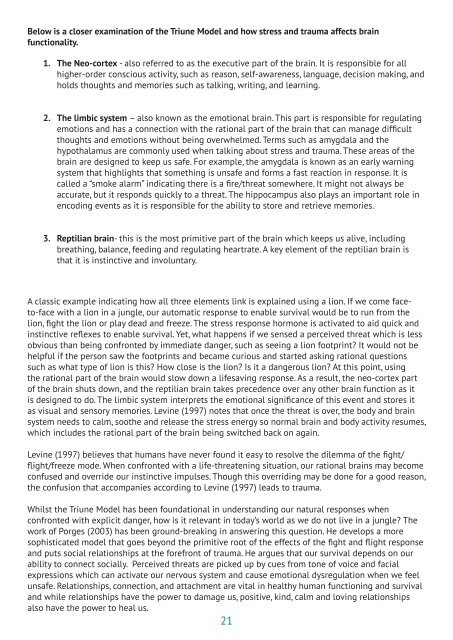Burnout in Churches and Christian Faith-Based Organisations
Burnout is a “syndrome of emotional exhaustion, depersonalization and reduced personal accomplishment that can occur among individuals who work with people in some capacity (Maslach 1996:193). This definition, whilst helpful, fails to convey the potentially life-shattering impact that burnout can have, as described in the words of ‘Peter’, a Christian leader who contributed to this guidance.
Burnout is a “syndrome of emotional exhaustion, depersonalization and reduced personal accomplishment that can occur among individuals who work with people in some capacity (Maslach 1996:193).
This definition, whilst helpful, fails to convey the potentially life-shattering impact that burnout can have, as described in the words of ‘Peter’, a Christian leader who contributed to this guidance.
Create successful ePaper yourself
Turn your PDF publications into a flip-book with our unique Google optimized e-Paper software.
Below is a closer exam<strong>in</strong>ation of the Triune Model <strong>and</strong> how stress <strong>and</strong> trauma affects bra<strong>in</strong><br />
functionality.<br />
1. The Neo-cortex - also referred to as the executive part of the bra<strong>in</strong>. It is responsible for all<br />
higher-order conscious activity, such as reason, self-awareness, language, decision mak<strong>in</strong>g, <strong>and</strong><br />
holds thoughts <strong>and</strong> memories such as talk<strong>in</strong>g, writ<strong>in</strong>g, <strong>and</strong> learn<strong>in</strong>g.<br />
2. The limbic system – also known as the emotional bra<strong>in</strong>. This part is responsible for regulat<strong>in</strong>g<br />
emotions <strong>and</strong> has a connection with the rational part of the bra<strong>in</strong> that can manage difficult<br />
thoughts <strong>and</strong> emotions without be<strong>in</strong>g overwhelmed. Terms such as amygdala <strong>and</strong> the<br />
hypothalamus are commonly used when talk<strong>in</strong>g about stress <strong>and</strong> trauma. These areas of the<br />
bra<strong>in</strong> are designed to keep us safe. For example, the amygdala is known as an early warn<strong>in</strong>g<br />
system that highlights that someth<strong>in</strong>g is unsafe <strong>and</strong> forms a fast reaction <strong>in</strong> response. It is<br />
called a “smoke alarm” <strong>in</strong>dicat<strong>in</strong>g there is a fire/threat somewhere. It might not always be<br />
accurate, but it responds quickly to a threat. The hippocampus also plays an important role <strong>in</strong><br />
encod<strong>in</strong>g events as it is responsible for the ability to store <strong>and</strong> retrieve memories.<br />
3. Reptilian bra<strong>in</strong>- this is the most primitive part of the bra<strong>in</strong> which keeps us alive, <strong>in</strong>clud<strong>in</strong>g<br />
breath<strong>in</strong>g, balance, feed<strong>in</strong>g <strong>and</strong> regulat<strong>in</strong>g heartrate. A key element of the reptilian bra<strong>in</strong> is<br />
that it is <strong>in</strong>st<strong>in</strong>ctive <strong>and</strong> <strong>in</strong>voluntary.<br />
A classic example <strong>in</strong>dicat<strong>in</strong>g how all three elements l<strong>in</strong>k is expla<strong>in</strong>ed us<strong>in</strong>g a lion. If we come faceto-face<br />
with a lion <strong>in</strong> a jungle, our automatic response to enable survival would be to run from the<br />
lion, fight the lion or play dead <strong>and</strong> freeze. The stress response hormone is activated to aid quick <strong>and</strong><br />
<strong>in</strong>st<strong>in</strong>ctive reflexes to enable survival. Yet, what happens if we sensed a perceived threat which is less<br />
obvious than be<strong>in</strong>g confronted by immediate danger, such as see<strong>in</strong>g a lion footpr<strong>in</strong>t? It would not be<br />
helpful if the person saw the footpr<strong>in</strong>ts <strong>and</strong> became curious <strong>and</strong> started ask<strong>in</strong>g rational questions<br />
such as what type of lion is this? How close is the lion? Is it a dangerous lion? At this po<strong>in</strong>t, us<strong>in</strong>g<br />
the rational part of the bra<strong>in</strong> would slow down a lifesav<strong>in</strong>g response. As a result, the neo-cortex part<br />
of the bra<strong>in</strong> shuts down, <strong>and</strong> the reptilian bra<strong>in</strong> takes precedence over any other bra<strong>in</strong> function as it<br />
is designed to do. The limbic system <strong>in</strong>terprets the emotional significance of this event <strong>and</strong> stores it<br />
as visual <strong>and</strong> sensory memories. Lev<strong>in</strong>e (1997) notes that once the threat is over, the body <strong>and</strong> bra<strong>in</strong><br />
system needs to calm, soothe <strong>and</strong> release the stress energy so normal bra<strong>in</strong> <strong>and</strong> body activity resumes,<br />
which <strong>in</strong>cludes the rational part of the bra<strong>in</strong> be<strong>in</strong>g switched back on aga<strong>in</strong>.<br />
Lev<strong>in</strong>e (1997) believes that humans have never found it easy to resolve the dilemma of the fight/<br />
flight/freeze mode. When confronted with a life-threaten<strong>in</strong>g situation, our rational bra<strong>in</strong>s may become<br />
confused <strong>and</strong> override our <strong>in</strong>st<strong>in</strong>ctive impulses. Though this overrid<strong>in</strong>g may be done for a good reason,<br />
the confusion that accompanies accord<strong>in</strong>g to Lev<strong>in</strong>e (1997) leads to trauma.<br />
Whilst the Triune Model has been foundational <strong>in</strong> underst<strong>and</strong><strong>in</strong>g our natural responses when<br />
confronted with explicit danger, how is it relevant <strong>in</strong> today’s world as we do not live <strong>in</strong> a jungle? The<br />
work of Porges (2003) has been ground-break<strong>in</strong>g <strong>in</strong> answer<strong>in</strong>g this question. He develops a more<br />
sophisticated model that goes beyond the primitive root of the effects of the fight <strong>and</strong> flight response<br />
<strong>and</strong> puts social relationships at the forefront of trauma. He argues that our survival depends on our<br />
ability to connect socially. Perceived threats are picked up by cues from tone of voice <strong>and</strong> facial<br />
expressions which can activate our nervous system <strong>and</strong> cause emotional dysregulation when we feel<br />
unsafe. Relationships, connection, <strong>and</strong> attachment are vital <strong>in</strong> healthy human function<strong>in</strong>g <strong>and</strong> survival<br />
<strong>and</strong> while relationships have the power to damage us, positive, k<strong>in</strong>d, calm <strong>and</strong> lov<strong>in</strong>g relationships<br />
also have the power to heal us.<br />
21



